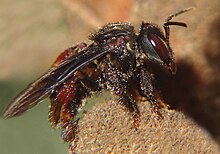| Trigona spinipes | |
|---|---|

| |
| Scientific classification | |
| Domain: | Eukaryota |
| Kingdom: | Animalia |
| Phylum: | Arthropoda |
| Class: | Insecta |
| Order: | Hymenoptera |
| Family: | Apidae |
| Genus: | Trigona |
| Species: | T. spinipes
|
| Binomial name | |
| Trigona spinipes (Fabricius, 1793)
| |

| |
| Found in parts of Brazil, Argentina, and Paraguay | |
| Synonyms | |
|
Trigona ruficrus Latreille, 1804 | |
Trigona spinipes is a species of stingless bee. It occurs in Brazil, where it is called arapuá, aripuá, irapuá, japurá or abelha-cachorro ("dog-bee"). The species name means "spiny feet" in Latin. Trigona spinipes builds its nest on trees (or on buildings and other human structures), out of mud, resin, wax, and assorted debris, including dung. Therefore, its honey is not fit for consumption, even though it is reputed to be of good quality by itself, and is used in folk medicine. Colonies may have from 5,000 to over 100,000 workers.
T. spinipes will attack in swarms when they feel the nest is threatened. They cannot sting, and their bite is not very effective. Their main weapon against predatory animals, including human beings, is to entangle themselves in the victim's hair and buzz loudly. They will also aggressively penetrate human bodily openings such as nasal and auditory orifices when in attack mode.
T. spinipes uses odor trails, sometimes extending several hundred metres, in order to lead nestmates from the hive to a food source. Moreover, it can "eavesdrop" on chemical signals used by other bee species (such as carpenter bees, Africanized honeybees and other stingless bees) for the same purpose, killing them or driving them away to take over their food source.[1]
The bee has been considered an agricultural pest for some crops, such as passion fruit, because it damages leaves and flowers while collecting nest materials, and tunnels through the unopened flowers to collect the nectar (thus frustrating their normal pollinators).[2] On the other hand, they are significant pollinators on their own, e.g. for onions.[3]
- ^ James C. Nieh; Lillian S. Barreto; Felipe A. L. Contrera & Vera L. Imperatriz-Fonseca (2004). "Olfactory eavesdropping by a competitively foraging stingless bee, Trigona spinipes". Proceedings of the Royal Society of London B. 271 (1548): 1633–1640. doi:10.1098/rspb.2004.2717. PMC 1691773. PMID 15306311.
- ^ Arlindo L. Boiça Jr.; Terezinha M. dos Santos & Jairo Passilongo (2004). "Trigona spinipes (Fabr.) (Hymenoptera: Apidae) em Espécies de Maracujazeiro: Flutuação Populacional, Horário de Visitação e Danos às Flores". Neotropical Entomology. 33 (2): 135–139. doi:10.1590/s1519-566x2004000200002. hdl:11449/2314.
- ^ Maria C. A. Lorenzon, Ângelo R. Rodrigues, and João R. G.C. de Souza (1993). "Comportamento polinizador de Trigona spinipes (Hymeotpera: Apidae) na florada da cebola (Allium cepa L.) híbrida". Pesquisa Agropecuária Brasileira. 28 (2): 217–221.
{{cite journal}}: CS1 maint: multiple names: authors list (link)